Designing the Engineering Parameters of the Sea Ice Based on a Refined Grid in the Southern Bohai Sea
Abstract
1. Introduction
2. Materials and Methods
2.1. Study Area
2.2. Sea Ice Concentration, Thickness, and Duration
2.3. Sea Ice Strength
2.4. Sensitivity Analysis
2.5. Model Verification
2.6. Return Period Design
3. Results
3.1. Ice Duration
3.2. Level Ice Thickness
3.3. Sea Ice Concentration
3.4. Sea Ice Uniaxial Compressive Strength
3.5. Sea Ice Shear Strength
3.6. Sea Ice Flexural Strength
3.7. Sea Ice Tensile Strength
4. Discussion
4.1. The Selection of Sea Ice Strength Formulae
4.2. Comparions with Original CNOOC Guideline
4.3. Potential Impacts of Climate Change on Bohai Sea Ice Engineering
4.4. Limitations of the Study
5. Conclusions
Author Contributions
Funding
Data Availability Statement
Acknowledgments
Conflicts of Interest
Appendix A
| Grid No. | Return Period/Year | |||||||
|---|---|---|---|---|---|---|---|---|
| 100 | 50 | 25 | 20 | 10 | 5 | 2 | 1 | |
| 1 | 2.14 | 2.12 | 2.09 | 2.08 | 2.05 | 2.01 | 1.93 | 1.88 |
| 2 | 2.13 | 2.11 | 2.08 | 2.07 | 2.05 | 2.01 | 1.95 | 1.89 |
| 3 | 2.14 | 2.12 | 2.09 | 2.08 | 2.05 | 2.02 | 1.95 | 1.89 |
| 4 | 2.14 | 2.12 | 2.09 | 2.08 | 2.06 | 2.02 | 1.95 | 1.89 |
| 5 | 2.14 | 2.11 | 2.09 | 2.08 | 2.05 | 2.02 | 1.95 | 1.89 |
| 6 | 2.06 | 2.04 | 2.02 | 2.02 | 1.99 | 1.96 | 1.90 | 1.85 |
| 7 | 2.27 | 2.24 | 2.21 | 2.20 | 2.16 | 2.12 | 2.04 | 1.96 |
| 8 | 2.28 | 2.25 | 2.22 | 2.21 | 2.17 | 2.13 | 2.05 | 1.97 |
| 9 | 2.28 | 2.25 | 2.22 | 2.21 | 2.18 | 2.13 | 2.05 | 1.97 |
| 10 | 2.28 | 2.26 | 2.23 | 2.21 | 2.18 | 2.13 | 2.05 | 1.98 |
| 11 | 2.28 | 2.25 | 2.22 | 2.21 | 2.18 | 2.13 | 2.05 | 1.98 |
| 12 | 2.28 | 2.26 | 2.23 | 2.22 | 2.18 | 2.13 | 2.05 | 1.98 |
| 13 | 2.29 | 2.26 | 2.23 | 2.22 | 2.18 | 2.14 | 2.06 | 1.98 |
| 14 | 2.22 | 2.19 | 2.16 | 2.15 | 2.12 | 2.08 | 2.01 | 1.94 |
| 15 | 2.22 | 2.19 | 2.17 | 2.16 | 2.12 | 2.09 | 2.01 | 1.95 |
| 16 | 2.21 | 2.19 | 2.16 | 2.15 | 2.12 | 2.08 | 2.01 | 1.94 |
| 17 | 2.21 | 2.19 | 2.16 | 2.15 | 2.12 | 2.08 | 2.01 | 1.94 |
| 18 | 2.22 | 2.19 | 2.17 | 2.16 | 2.13 | 2.09 | 2.01 | 1.95 |
| 19 | 2.22 | 2.19 | 2.17 | 2.16 | 2.13 | 2.09 | 2.01 | 1.95 |
| 20 | 2.10 | 2.08 | 2.05 | 2.05 | 2.02 | 1.99 | 1.92 | 1.87 |
| 21 | 2.10 | 2.08 | 2.06 | 2.05 | 2.02 | 1.99 | 1.93 | 1.87 |
| 22 | 2.10 | 2.08 | 2.05 | 2.05 | 2.02 | 1.99 | 1.92 | 1.87 |
| 23 | 2.10 | 2.08 | 2.06 | 2.05 | 2.02 | 1.99 | 1.93 | 1.87 |
| 24 | 2.10 | 2.08 | 2.06 | 2.05 | 2.03 | 1.99 | 1.93 | 1.88 |
| 25 | 2.10 | 2.08 | 2.06 | 2.05 | 2.02 | 1.99 | 1.93 | 1.87 |
| 26 | 2.10 | 2.08 | 2.06 | 2.05 | 2.02 | 1.99 | 1.93 | 1.87 |
| 27 | 2.11 | 2.09 | 2.06 | 2.06 | 2.03 | 2.00 | 1.93 | 1.88 |
| 28 | 2.10 | 2.08 | 2.06 | 2.05 | 2.02 | 1.99 | 1.93 | 1.87 |
| 29 | 2.17 | 2.15 | 2.12 | 2.11 | 2.08 | 2.04 | 1.97 | 1.91 |
| 30 | 2.17 | 2.15 | 2.12 | 2.11 | 2.08 | 2.04 | 1.97 | 1.91 |
| 31 | 2.04 | 2.02 | 2.00 | 2.00 | 1.97 | 1.94 | 1.88 | 1.83 |
| 32 | 2.04 | 2.02 | 2.00 | 1.99 | 1.97 | 1.94 | 1.88 | 1.83 |
| 33 | 2.04 | 2.02 | 2.00 | 1.99 | 1.96 | 1.93 | 1.88 | 1.83 |
| 34 | 2.05 | 2.03 | 2.01 | 2.00 | 1.97 | 1.94 | 1.88 | 1.83 |
| 35 | 2.05 | 2.03 | 2.01 | 2.00 | 1.97 | 1.94 | 1.88 | 1.83 |
| 36 | 2.04 | 2.03 | 2.01 | 2.00 | 1.97 | 1.94 | 1.88 | 1.83 |
| 37 | 2.04 | 2.03 | 2.01 | 2.00 | 1.97 | 1.94 | 1.89 | 1.83 |
| 38 | 2.04 | 2.02 | 2.00 | 1.99 | 1.97 | 1.94 | 1.88 | 1.83 |
| 39 | 2.04 | 2.02 | 2.00 | 1.99 | 1.97 | 1.94 | 1.88 | 1.83 |
| 40 | 2.05 | 2.03 | 2.01 | 2.00 | 1.98 | 1.95 | 1.89 | 1.84 |
| 41 | 2.05 | 2.03 | 2.01 | 2.00 | 1.98 | 1.95 | 1.89 | 1.84 |
| 42 | 2.05 | 2.03 | 2.01 | 2.00 | 1.97 | 1.94 | 1.89 | 1.83 |
| 43 | 2.05 | 2.03 | 2.01 | 2.00 | 1.98 | 1.95 | 1.89 | 1.84 |
| 44 | 2.05 | 2.03 | 2.01 | 2.01 | 1.98 | 1.95 | 1.89 | 1.84 |
| 45 | 2.05 | 2.03 | 2.01 | 2.00 | 1.97 | 1.94 | 1.89 | 1.84 |
| 46 | 2.05 | 2.03 | 2.01 | 2.00 | 1.98 | 1.94 | 1.89 | 1.84 |
| 47 | 2.02 | 2.00 | 1.98 | 1.97 | 1.95 | 1.92 | 1.87 | 1.82 |
| 48 | 2.04 | 2.02 | 2.00 | 1.99 | 1.97 | 1.94 | 1.88 | 1.83 |
| 49 | 2.04 | 2.02 | 2.00 | 1.99 | 1.97 | 1.94 | 1.88 | 1.83 |
| 50 | 2.04 | 2.02 | 2.00 | 1.99 | 1.97 | 1.94 | 1.88 | 1.83 |
| 51 | 2.02 | 2.00 | 1.98 | 1.98 | 1.95 | 1.92 | 1.87 | 1.82 |
| 52 | 2.02 | 2.00 | 1.98 | 1.97 | 1.95 | 1.92 | 1.86 | 1.81 |
| 53 | 2.02 | 2.00 | 1.98 | 1.97 | 1.95 | 1.92 | 1.86 | 1.82 |
| Grid No. | Return Period/Year | |||||||
|---|---|---|---|---|---|---|---|---|
| 100 | 50 | 25 | 20 | 10 | 5 | 2 | 1 | |
| 1 | 1071 | 1059 | 1045 | 1040 | 1024 | 1004 | 965 | 938 |
| 2 | 1063 | 1053 | 1041 | 1037 | 1023 | 1006 | 973 | 945 |
| 3 | 1069 | 1058 | 1046 | 1042 | 1027 | 1009 | 976 | 947 |
| 4 | 1070 | 1059 | 1047 | 1042 | 1028 | 1010 | 977 | 947 |
| 5 | 1068 | 1057 | 1045 | 1040 | 1026 | 1008 | 974 | 944 |
| 6 | 1032 | 1022 | 1012 | 1008 | 996 | 980 | 951 | 926 |
| 7 | 1133 | 1119 | 1104 | 1099 | 1081 | 1059 | 1018 | 981 |
| 8 | 1140 | 1126 | 1111 | 1105 | 1087 | 1065 | 1023 | 986 |
| 9 | 1141 | 1127 | 1112 | 1106 | 1088 | 1066 | 1024 | 987 |
| 10 | 1142 | 1128 | 1113 | 1107 | 1089 | 1067 | 1025 | 988 |
| 11 | 1141 | 1127 | 1112 | 1107 | 1088 | 1067 | 1025 | 988 |
| 12 | 1142 | 1128 | 1113 | 1108 | 1089 | 1067 | 1026 | 989 |
| 13 | 1143 | 1130 | 1115 | 1109 | 1091 | 1069 | 1028 | 991 |
| 14 | 1108 | 1096 | 1082 | 1077 | 1061 | 1042 | 1004 | 972 |
| 15 | 1109 | 1096 | 1083 | 1078 | 1062 | 1043 | 1005 | 973 |
| 16 | 1107 | 1094 | 1081 | 1076 | 1060 | 1041 | 1003 | 971 |
| 17 | 1107 | 1094 | 1081 | 1076 | 1060 | 1041 | 1003 | 971 |
| 18 | 1109 | 1097 | 1084 | 1079 | 1063 | 1043 | 1006 | 973 |
| 19 | 1109 | 1097 | 1084 | 1079 | 1063 | 1043 | 1006 | 973 |
| 20 | 1049 | 1039 | 1027 | 1023 | 1010 | 993 | 962 | 934 |
| 21 | 1051 | 1041 | 1029 | 1025 | 1012 | 995 | 964 | 936 |
| 22 | 1049 | 1039 | 1027 | 1023 | 1010 | 993 | 962 | 934 |
| 23 | 1051 | 1041 | 1029 | 1025 | 1012 | 995 | 964 | 936 |
| 24 | 1052 | 1042 | 1031 | 1027 | 1013 | 997 | 965 | 938 |
| 25 | 1050 | 1040 | 1028 | 1025 | 1011 | 994 | 963 | 935 |
| 26 | 1050 | 1039 | 1028 | 1024 | 1010 | 994 | 963 | 935 |
| 27 | 1053 | 1043 | 1032 | 1028 | 1014 | 998 | 966 | 939 |
| 28 | 1051 | 1041 | 1030 | 1026 | 1012 | 996 | 964 | 937 |
| 29 | 1085 | 1073 | 1060 | 1056 | 1040 | 1022 | 986 | 955 |
| 30 | 1085 | 1073 | 1060 | 1056 | 1040 | 1022 | 986 | 955 |
| 31 | 1021 | 1012 | 1001 | 998 | 985 | 970 | 941 | 916 |
| 32 | 1019 | 1010 | 999 | 996 | 983 | 968 | 940 | 914 |
| 33 | 1018 | 1009 | 999 | 995 | 982 | 967 | 939 | 913 |
| 34 | 1023 | 1014 | 1003 | 999 | 987 | 972 | 942 | 917 |
| 35 | 1023 | 1013 | 1003 | 999 | 986 | 971 | 942 | 917 |
| 36 | 1022 | 1013 | 1003 | 999 | 986 | 971 | 942 | 917 |
| 37 | 1022 | 1013 | 1003 | 999 | 986 | 971 | 943 | 917 |
| 38 | 1021 | 1011 | 1001 | 997 | 985 | 970 | 941 | 916 |
| 39 | 1020 | 1011 | 1000 | 997 | 984 | 969 | 940 | 915 |
| 40 | 1025 | 1015 | 1005 | 1001 | 989 | 973 | 944 | 919 |
| 41 | 1024 | 1015 | 1004 | 1000 | 988 | 973 | 943 | 918 |
| 42 | 1023 | 1014 | 1003 | 1000 | 987 | 972 | 943 | 917 |
| 43 | 1024 | 1014 | 1004 | 1000 | 988 | 973 | 944 | 919 |
| 44 | 1027 | 1017 | 1007 | 1003 | 990 | 975 | 946 | 921 |
| 45 | 1024 | 1014 | 1004 | 1000 | 987 | 972 | 943 | 918 |
| 46 | 1024 | 1014 | 1004 | 1000 | 988 | 972 | 943 | 918 |
| 47 | 1010 | 1001 | 991 | 987 | 975 | 961 | 933 | 909 |
| 48 | 1019 | 1010 | 999 | 996 | 983 | 968 | 939 | 914 |
| 49 | 1019 | 1010 | 999 | 996 | 983 | 968 | 939 | 914 |
| 50 | 1019 | 1010 | 1000 | 996 | 984 | 969 | 940 | 914 |
| 51 | 1010 | 1001 | 991 | 988 | 976 | 961 | 934 | 910 |
| 52 | 1008 | 999 | 989 | 986 | 974 | 959 | 932 | 907 |
| 53 | 1009 | 1000 | 990 | 986 | 974 | 960 | 932 | 908 |
| Grid No. | Return Period/Year | |||||||
|---|---|---|---|---|---|---|---|---|
| 100 | 50 | 25 | 20 | 10 | 5 | 2 | 1 | |
| 1 | 520 | 508 | 495 | 490 | 474 | 455 | 419 | 389 |
| 2 | 517 | 506 | 494 | 490 | 476 | 459 | 427 | 399 |
| 3 | 522 | 511 | 499 | 495 | 480 | 463 | 430 | 400 |
| 4 | 523 | 512 | 500 | 496 | 481 | 464 | 430 | 401 |
| 5 | 515 | 504 | 492 | 488 | 474 | 458 | 428 | 401 |
| 6 | 487 | 477 | 467 | 463 | 450 | 435 | 405 | 380 |
| 7 | 584 | 571 | 556 | 551 | 533 | 512 | 471 | 435 |
| 8 | 591 | 577 | 562 | 557 | 539 | 517 | 475 | 439 |
| 9 | 592 | 578 | 563 | 558 | 540 | 518 | 476 | 440 |
| 10 | 593 | 579 | 564 | 559 | 541 | 519 | 477 | 441 |
| 11 | 592 | 578 | 563 | 558 | 540 | 519 | 478 | 442 |
| 12 | 593 | 579 | 564 | 559 | 541 | 520 | 478 | 442 |
| 13 | 594 | 581 | 566 | 561 | 543 | 522 | 480 | 444 |
| 14 | 559 | 547 | 534 | 529 | 513 | 494 | 458 | 425 |
| 15 | 560 | 548 | 535 | 530 | 514 | 495 | 458 | 426 |
| 16 | 558 | 546 | 533 | 528 | 512 | 493 | 456 | 424 |
| 17 | 558 | 546 | 533 | 528 | 512 | 493 | 456 | 424 |
| 18 | 561 | 549 | 536 | 531 | 515 | 496 | 459 | 427 |
| 19 | 561 | 549 | 536 | 531 | 515 | 496 | 459 | 427 |
| 20 | 504 | 494 | 482 | 478 | 464 | 448 | 416 | 388 |
| 21 | 507 | 497 | 485 | 481 | 467 | 450 | 418 | 389 |
| 22 | 504 | 494 | 482 | 478 | 464 | 448 | 416 | 388 |
| 23 | 507 | 497 | 485 | 481 | 467 | 450 | 418 | 389 |
| 24 | 499 | 490 | 479 | 476 | 463 | 448 | 419 | 394 |
| 25 | 506 | 495 | 484 | 480 | 466 | 449 | 417 | 389 |
| 26 | 505 | 495 | 483 | 479 | 465 | 448 | 416 | 388 |
| 27 | 501 | 491 | 481 | 477 | 465 | 449 | 420 | 395 |
| 28 | 508 | 497 | 486 | 482 | 468 | 451 | 418 | 390 |
| 29 | 537 | 525 | 513 | 508 | 493 | 475 | 440 | 409 |
| 30 | 537 | 525 | 513 | 508 | 493 | 475 | 440 | 409 |
| 31 | 474 | 464 | 454 | 451 | 438 | 424 | 395 | 371 |
| 32 | 471 | 462 | 452 | 448 | 436 | 422 | 394 | 369 |
| 33 | 470 | 461 | 451 | 447 | 435 | 421 | 393 | 368 |
| 34 | 474 | 465 | 455 | 452 | 439 | 425 | 397 | 372 |
| 35 | 474 | 465 | 455 | 451 | 439 | 424 | 396 | 372 |
| 36 | 474 | 465 | 454 | 451 | 439 | 424 | 396 | 372 |
| 37 | 475 | 466 | 456 | 452 | 440 | 425 | 397 | 372 |
| 38 | 473 | 464 | 454 | 450 | 438 | 423 | 395 | 371 |
| 39 | 472 | 463 | 453 | 449 | 437 | 422 | 394 | 370 |
| 40 | 477 | 468 | 457 | 454 | 442 | 427 | 398 | 373 |
| 41 | 476 | 467 | 456 | 453 | 441 | 426 | 398 | 373 |
| 42 | 475 | 466 | 456 | 452 | 440 | 425 | 397 | 372 |
| 43 | 477 | 468 | 457 | 454 | 442 | 427 | 398 | 373 |
| 44 | 479 | 470 | 460 | 456 | 444 | 429 | 400 | 375 |
| 45 | 475 | 466 | 456 | 452 | 440 | 425 | 397 | 373 |
| 46 | 475 | 466 | 456 | 452 | 440 | 426 | 397 | 373 |
| 47 | 466 | 457 | 446 | 443 | 431 | 416 | 388 | 363 |
| 48 | 471 | 462 | 452 | 448 | 436 | 421 | 393 | 369 |
| 49 | 471 | 462 | 452 | 448 | 436 | 421 | 393 | 369 |
| 50 | 471 | 462 | 452 | 449 | 436 | 422 | 394 | 369 |
| 51 | 467 | 458 | 447 | 444 | 431 | 416 | 388 | 363 |
| 52 | 463 | 454 | 444 | 441 | 429 | 414 | 386 | 361 |
| 53 | 464 | 455 | 445 | 441 | 429 | 414 | 386 | 362 |
| Grid No. | Return Period/Year | |||||||
|---|---|---|---|---|---|---|---|---|
| 100 | 50 | 25 | 20 | 10 | 5 | 2 | 1 | |
| 1 | 233 | 224 | 214 | 210 | 198 | 184 | 157 | 136 |
| 2 | 232 | 224 | 215 | 212 | 201 | 188 | 163 | 142 |
| 3 | 233 | 225 | 216 | 213 | 202 | 189 | 165 | 144 |
| 4 | 233 | 225 | 217 | 213 | 203 | 190 | 166 | 144 |
| 5 | 230 | 223 | 214 | 211 | 200 | 188 | 164 | 143 |
| 6 | 208 | 201 | 193 | 190 | 181 | 169 | 147 | 127 |
| 7 | 290 | 279 | 267 | 263 | 248 | 231 | 197 | 168 |
| 8 | 296 | 284 | 272 | 268 | 253 | 235 | 201 | 171 |
| 9 | 296 | 285 | 273 | 269 | 254 | 236 | 202 | 172 |
| 10 | 297 | 286 | 274 | 269 | 255 | 237 | 202 | 172 |
| 11 | 292 | 281 | 270 | 265 | 252 | 235 | 202 | 174 |
| 12 | 292 | 282 | 270 | 266 | 252 | 235 | 203 | 175 |
| 13 | 294 | 283 | 272 | 268 | 254 | 237 | 205 | 177 |
| 14 | 266 | 257 | 247 | 243 | 231 | 216 | 187 | 162 |
| 15 | 267 | 258 | 247 | 244 | 231 | 216 | 188 | 162 |
| 16 | 265 | 256 | 246 | 242 | 230 | 215 | 186 | 161 |
| 17 | 265 | 256 | 246 | 242 | 230 | 215 | 186 | 161 |
| 18 | 267 | 258 | 248 | 244 | 232 | 217 | 188 | 163 |
| 19 | 267 | 258 | 248 | 244 | 232 | 217 | 188 | 163 |
| 20 | 219 | 212 | 203 | 200 | 190 | 178 | 155 | 134 |
| 21 | 221 | 213 | 205 | 202 | 192 | 180 | 156 | 135 |
| 22 | 219 | 212 | 203 | 200 | 190 | 178 | 155 | 134 |
| 23 | 221 | 213 | 205 | 202 | 192 | 180 | 156 | 135 |
| 24 | 222 | 215 | 206 | 203 | 193 | 181 | 157 | 136 |
| 25 | 220 | 213 | 204 | 201 | 191 | 179 | 155 | 135 |
| 26 | 220 | 212 | 204 | 201 | 191 | 179 | 155 | 135 |
| 27 | 223 | 216 | 207 | 204 | 194 | 182 | 158 | 137 |
| 28 | 222 | 214 | 205 | 202 | 192 | 180 | 156 | 136 |
| 29 | 249 | 240 | 230 | 226 | 215 | 200 | 173 | 149 |
| 30 | 249 | 240 | 230 | 226 | 215 | 200 | 173 | 149 |
| 31 | 202 | 194 | 186 | 183 | 173 | 161 | 139 | 121 |
| 32 | 201 | 193 | 184 | 181 | 171 | 159 | 138 | 120 |
| 33 | 199 | 191 | 183 | 180 | 170 | 158 | 137 | 119 |
| 34 | 203 | 195 | 187 | 184 | 174 | 162 | 140 | 122 |
| 35 | 203 | 195 | 186 | 183 | 173 | 162 | 140 | 121 |
| 36 | 202 | 195 | 186 | 183 | 173 | 161 | 140 | 121 |
| 37 | 203 | 195 | 187 | 184 | 174 | 162 | 140 | 122 |
| 38 | 202 | 194 | 185 | 182 | 172 | 160 | 139 | 121 |
| 39 | 201 | 193 | 184 | 181 | 172 | 160 | 138 | 120 |
| 40 | 204 | 196 | 188 | 185 | 175 | 163 | 141 | 123 |
| 41 | 203 | 196 | 187 | 184 | 174 | 163 | 141 | 122 |
| 42 | 203 | 195 | 187 | 184 | 174 | 162 | 140 | 122 |
| 43 | 203 | 195 | 187 | 184 | 174 | 163 | 141 | 123 |
| 44 | 205 | 197 | 189 | 186 | 176 | 165 | 143 | 124 |
| 45 | 203 | 196 | 187 | 184 | 174 | 162 | 140 | 122 |
| 46 | 203 | 196 | 187 | 184 | 174 | 162 | 141 | 122 |
| 47 | 195 | 187 | 179 | 176 | 166 | 155 | 133 | 116 |
| 48 | 201 | 193 | 184 | 181 | 171 | 159 | 137 | 120 |
| 49 | 201 | 193 | 184 | 181 | 171 | 159 | 137 | 120 |
| 50 | 202 | 193 | 185 | 182 | 171 | 159 | 138 | 120 |
| 51 | 194 | 186 | 178 | 175 | 165 | 154 | 133 | 116 |
| 52 | 192 | 184 | 176 | 173 | 164 | 152 | 132 | 115 |
| 53 | 193 | 185 | 176 | 174 | 164 | 153 | 132 | 115 |
References
- Wang, A.; Tang, M.; Zhao, Q.; Liu, Y.; Li, B.; Shi, Y.; Sui, J. Analysis of sea ice parameters for the design of an offshore wind farm in the Bohai Sea. Ocean Eng. 2021, 239, 109902. [Google Scholar] [CrossRef]
- Timco, G.W.; Weeks, W.F. A review of the engineering properties of sea ice. Cold Reg. Sci. Technol. 2010, 60, 107–129. [Google Scholar] [CrossRef]
- Li, Z.; Wang, Y. Design criteria of Bohai Sea ice-control engineering. Ocean Eng. 2000, 1, 61–64, 69. (In Chinese) [Google Scholar]
- Ji, S.; Wang, A.; Su, J.; Yue, Q. Experimental Studies on Elastic Modulus and Flexural Strength of Sea Ice in the Bohai Sea. J. Cold Reg. Eng. 2011, 25, 182–195. [Google Scholar] [CrossRef]
- Ji, S.; Liu, H.; Li, P.; Su, J. Experimental Studies on the Bohai Sea Ice Shear Strength. J. Cold Reg. Eng. 2013, 27, 244–254. [Google Scholar] [CrossRef]
- Wang, A.; Xu, N.; Ji, S. Characteristics of sea ice uniaxial compressive strength around the coast of Bohai Sea. Ocean Eng. 2014, 32, 82–88. (In Chinese) [Google Scholar]
- Shi, L.; Bai, Y.; Li, Z.; Cheng, B.; Leppäranta, M. Preliminary results on the relationship between thermal diffusivity and porosity of sea ice in the Antarctic. Chin. J. Polar Sci. 2009, 20, 72–80. [Google Scholar]
- Li, Z.; Zhang, L.; Lu, P.; Leppäranta, M.; Li, G. Experimental study on the effect of porosity on the uniaxial compressive strength of sea ice in Bohai Sea. Sci. China Technol. Sci. 2011, 54, 2429–2436. [Google Scholar] [CrossRef]
- Chen, X.; He, S.; He, W.; Wang, Z.; Ji, S. Tensile strength of sea ice using splitting tests based on the digital image correlation method. Adv. Polar Sci. 2021, 32, 374–381. [Google Scholar]
- Sun, J.; Chen, X.; Li, Q.; Gao, J.; Zhang, H.; Xu, Y. Temporal and spatial variation characteristics of sea ice conditions in the Bohai Sea from 1988 to 2018 based on remote sensing technology. J. Catastrophol. 2022, 37, 178–184. (In Chinese) [Google Scholar]
- Yan, Y.; Shao, D.; Gu, W.; Liu, C.; Li, Q.; Chao, J.; Tao, J.; Xu, Y. Multidecadal anomalies of Bohai Sea ice cover and potential climate driving factors during 1988–2015. Environ. Res. Lett. 2017, 12, 094014. [Google Scholar] [CrossRef]
- Ouyang, L.; Hui, F.; Zhu, L.; Cheng, X.; Cheng, B.; Shokr, M.; Zhao, J.; Ding, M.; Zeng, T. The spatiotemporal patterns of sea ice in the Bohai Sea during the winter seasons of 2000–2016. Int. J. Digit. Earth 2019, 12, 893–9098. [Google Scholar] [CrossRef]
- Yan, Y.; Uotila, P.; Huang, K.; Gu, W. Variability of sea ice area in the Bohai Sea from 1958 to 2015. Sci. Total Environ. 2020, 709, 136164. [Google Scholar] [CrossRef]
- Zheng, D.; Wang, Z.; Zhang, S.; Xu, P.; Zhou, Z. Interannual and indecadal variation of the sea ice in Bohai Sea and its mechanisms. Acta Oceanol. Sin. 2015, 37, 12–20. (In Chinese) [Google Scholar]
- Zhang, B. Regulations for Offshore Ice Condition & Application in China Sea; China National Offshore Oil Corporation: Beijing, China, 2002; Q/HSn 3000-2002. (In Chinese) [Google Scholar]
- Li, G.; Jiao, Y.; Chen, X.; Zhao, Y.; Li, R.; Guo, D.; Ge, L.; Hou, Q.; Wang, Q. Investigation of the recent ice characteristics in the Bohai Sea in the winters of 2005–2022 using multi-source data. Water 2024, 16, 290. [Google Scholar] [CrossRef]
- Karulina, M.; Marchenko, A.; Karulina, E.; Sodhi, D.; Sakharov, A.; Chistyakov, P. Full-scale flexural strength of sea ice and freshwater ice in Spitsbergen Fjords and North-West Barents Sea. Appl. Ocean Res. 2019, 90, 101853. [Google Scholar] [CrossRef]
- Aly, M.; Taylor, R.; Dudley, E.B.; Turnbull, I. Scale effect in ice flexural strength. J. Offshore Mech. Arct. Eng. Trans. ASME 2019, 141, 051501. [Google Scholar] [CrossRef]
- Huang, Y.; Han, J.; Sun, J.; Zhao, T. Size effects on the in-situ compressive behavior of first-year sea ice. Appl. Ocean Res. 2025, 154, 104395. [Google Scholar] [CrossRef]
- Chai, W.; Leira, B.; Høyland, K.V.; Sinsabvarodom, C.; Yu, Z. Statistics of thickness and strength of first-year ice along the Northern Sea Route. J. Mar. Sci. Technol. 2021, 26, 331–343. [Google Scholar] [CrossRef]
- Tarovik, O.; Yakimov, V.; Dobrodeev, A.; Li, F. Influence of seasonal and regional variation of ice properties on ship performance in the Arctic. Ocean Eng. 2022, 257, 111563. [Google Scholar] [CrossRef]
- Hvatov, A.; Nikitin, N.O.; Kalyuzhnaya, A.V.; Kosukhin, S.S. Adaptation of NEMO-LIM3 model for multigrid high resolution Arctic simulation. Ocean Model. 2019, 141, 101427. [Google Scholar] [CrossRef]
- Li, R.; Lu, Y.; Hu, X.; Guo, D.; Zhao, P.; Wang, N.; Lee, K.; Zhang, B. Space-time variations of sea ice in Bohai Sea in the winter of 2009–2010 simulated with a coupled ocean and ice model. J. Oceanogr. 2021, 77, 234–258. [Google Scholar] [CrossRef]
- Xu, N.; Chen, W.; Yuan, S.; Yue, Q.; Li, Z.; Ji, S.; Liu, X.; Shi, W.; Zhang, D.; Wang, R. The Specification for Engineering Sea Ice Techniques; State Oceanic Administration: Beijing, China, 2017; HY/T 047-2016. (In Chinese) [Google Scholar]
- Meng, G.; Zhang, M.; Li, Z.; Sui, J.; Yan, D. Compressive strength of low salinity sea ice and Yellow River ice in the Yellow River Estuary. Mar. Environ. Sci. 1994, 3, 72–80. (In Chinese) [Google Scholar]

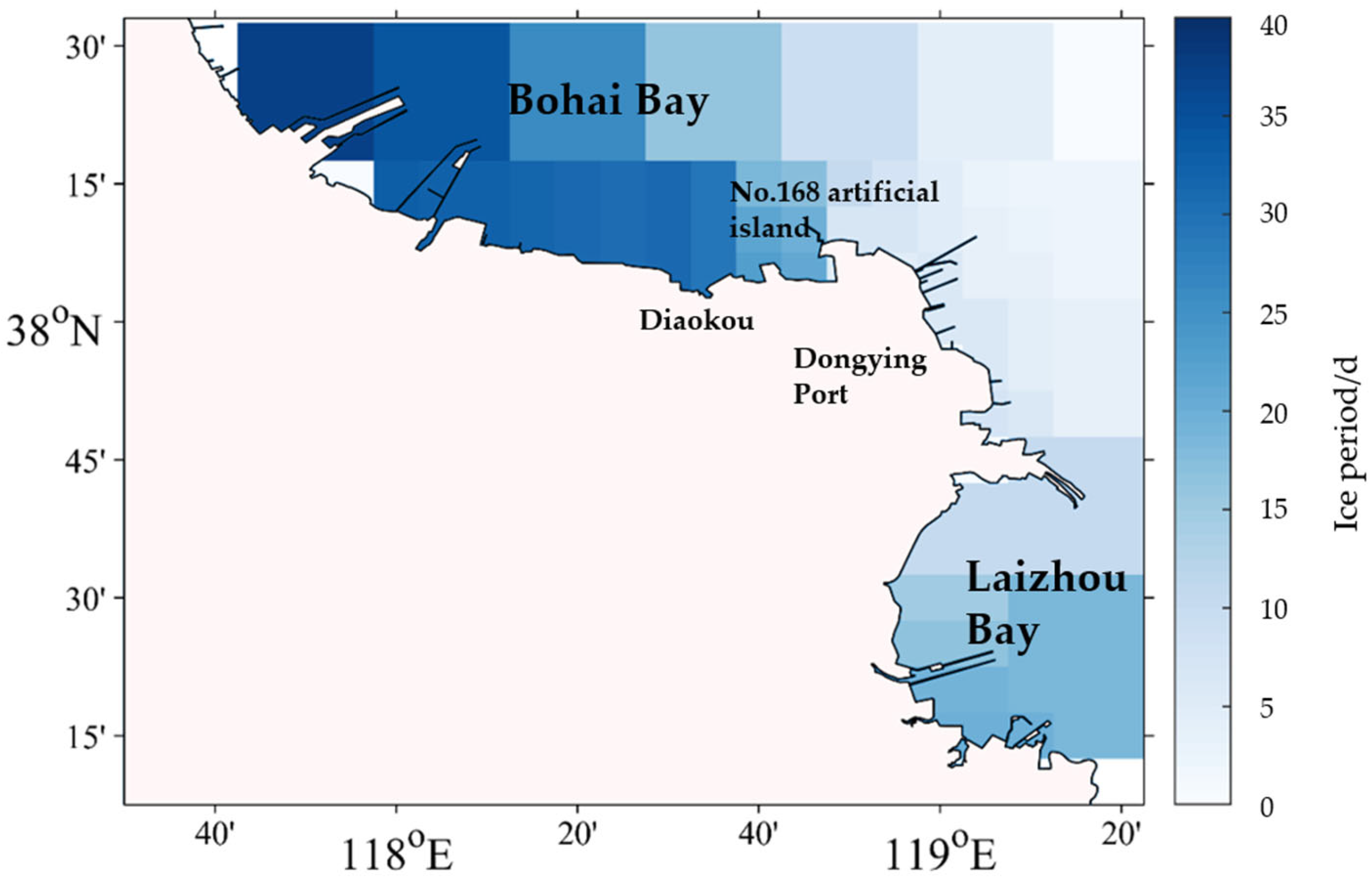
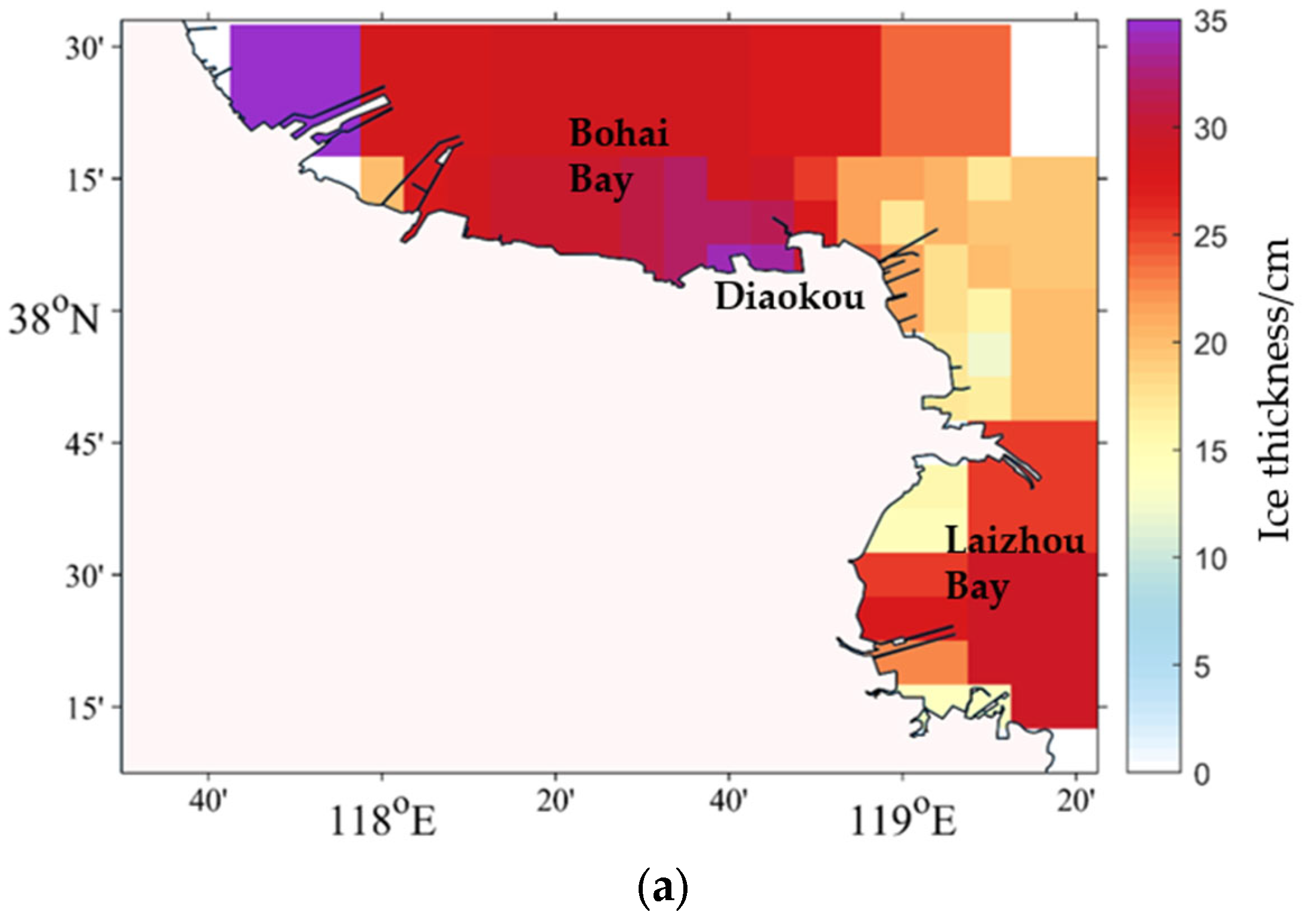
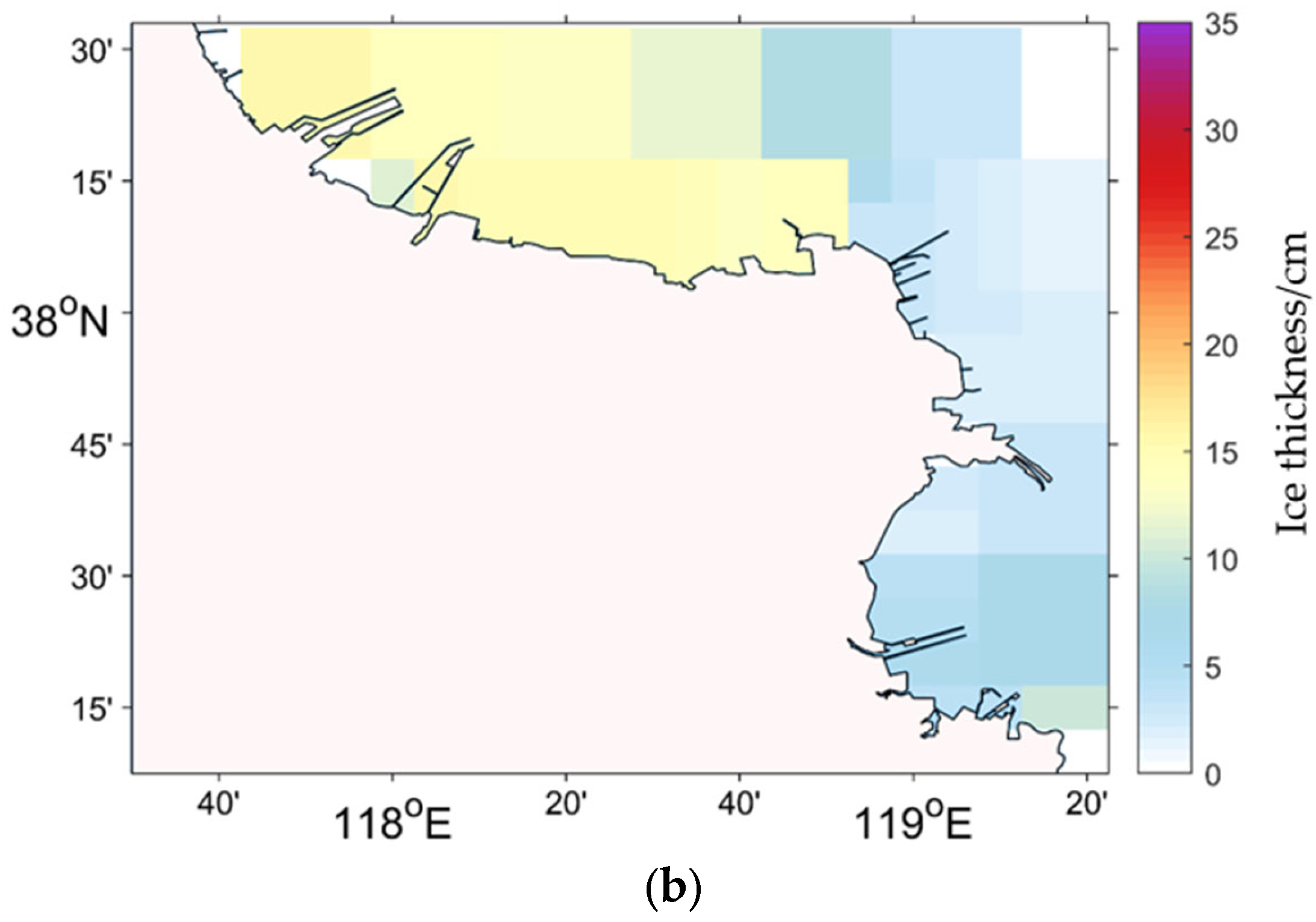

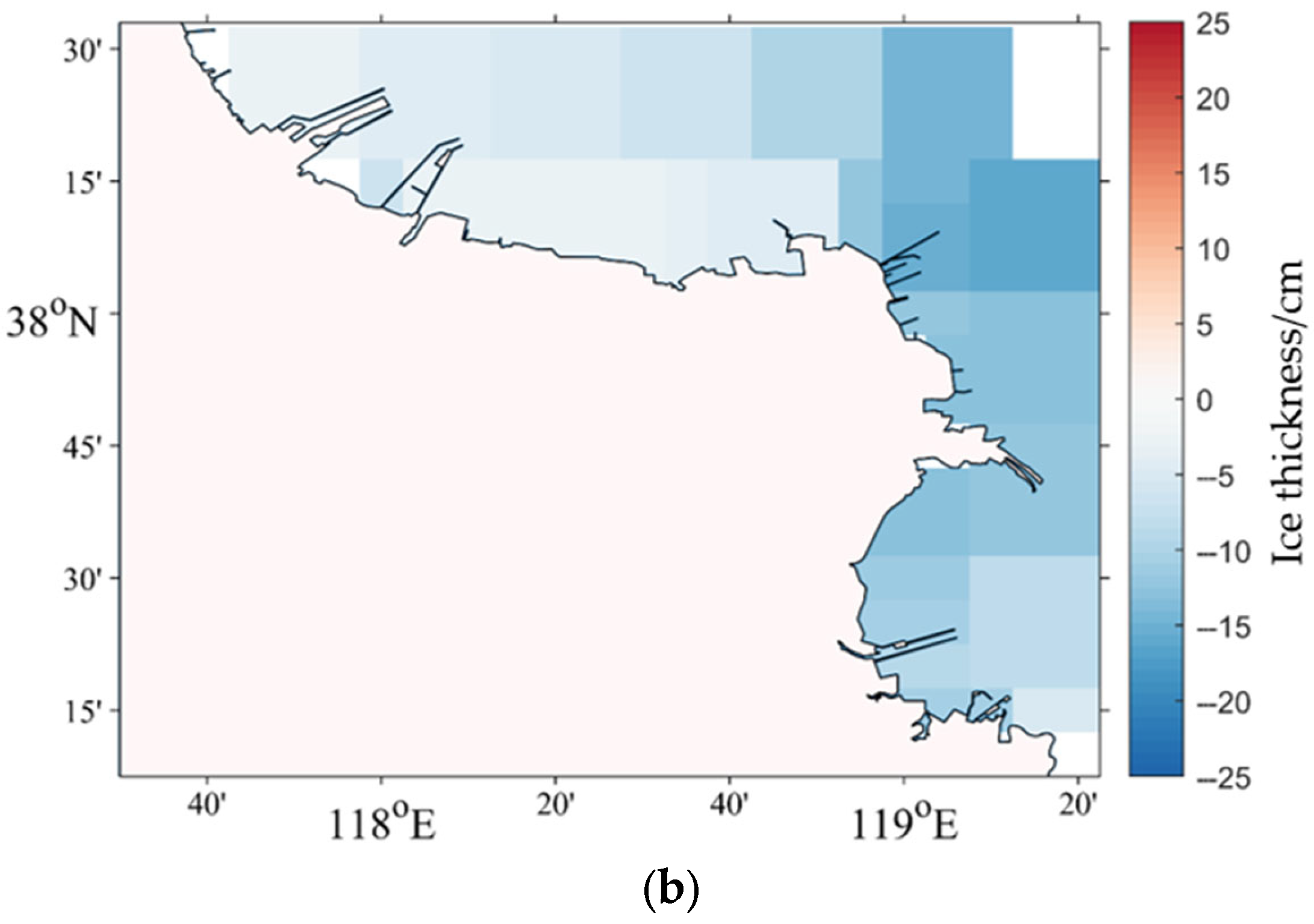

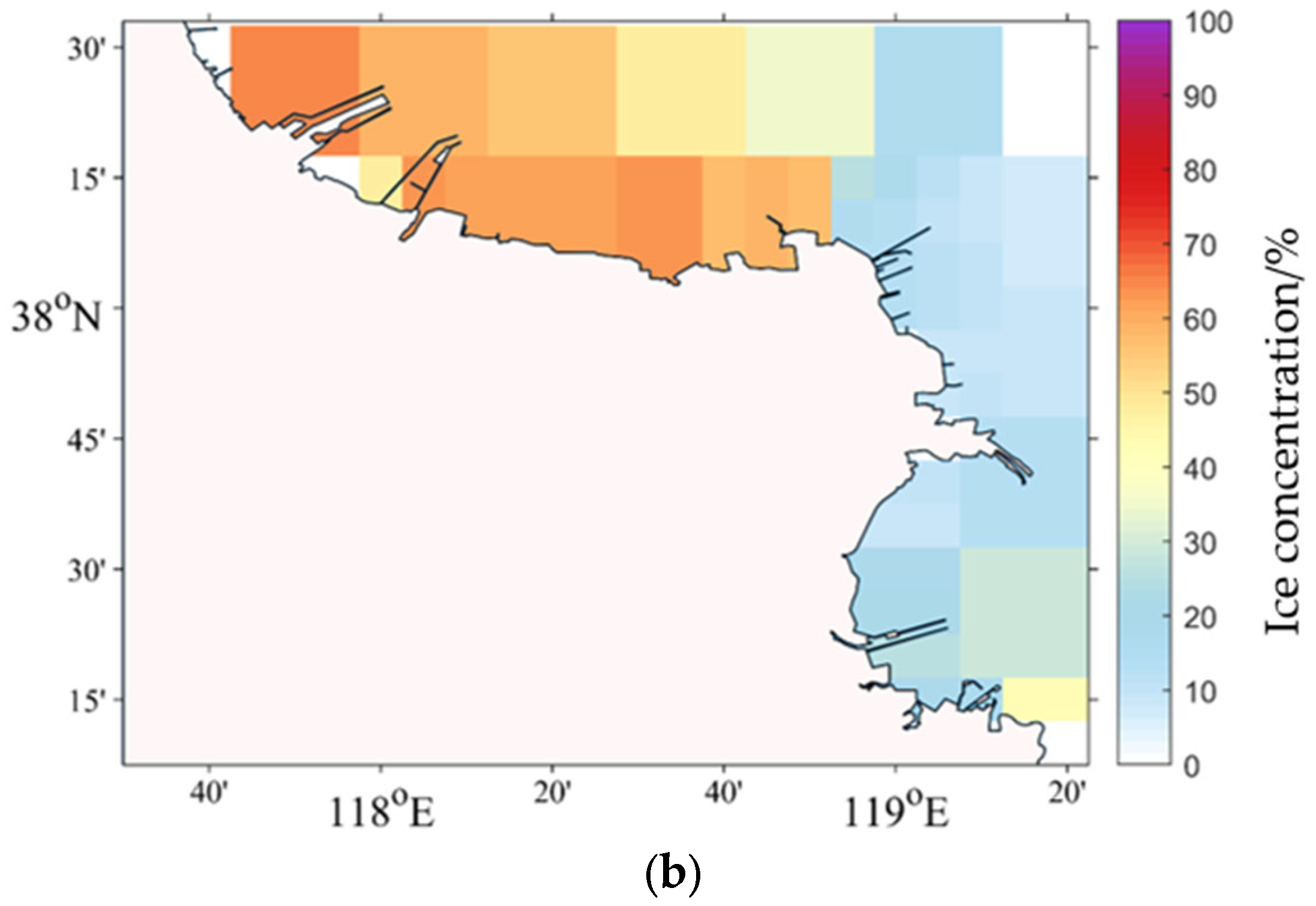
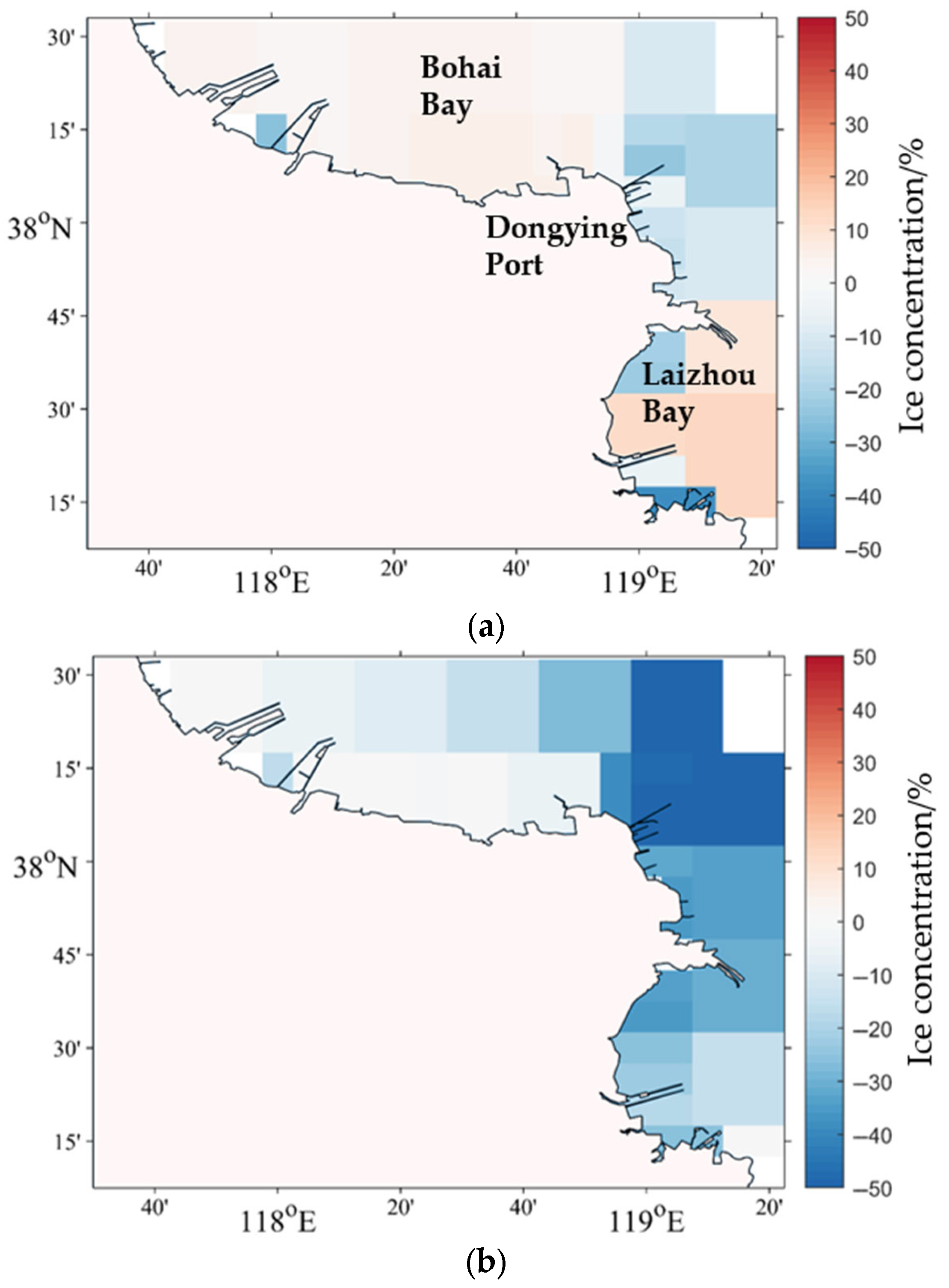

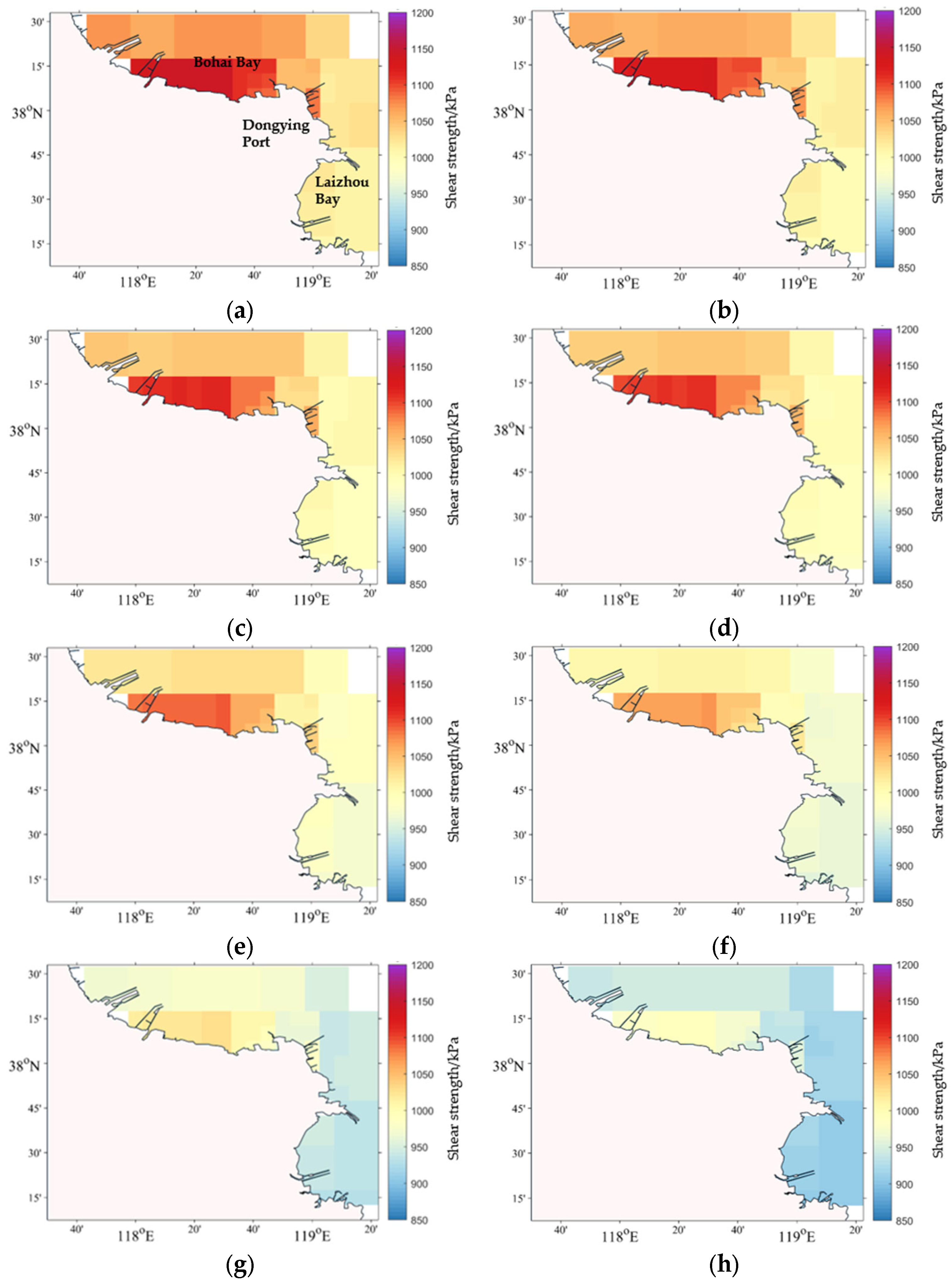
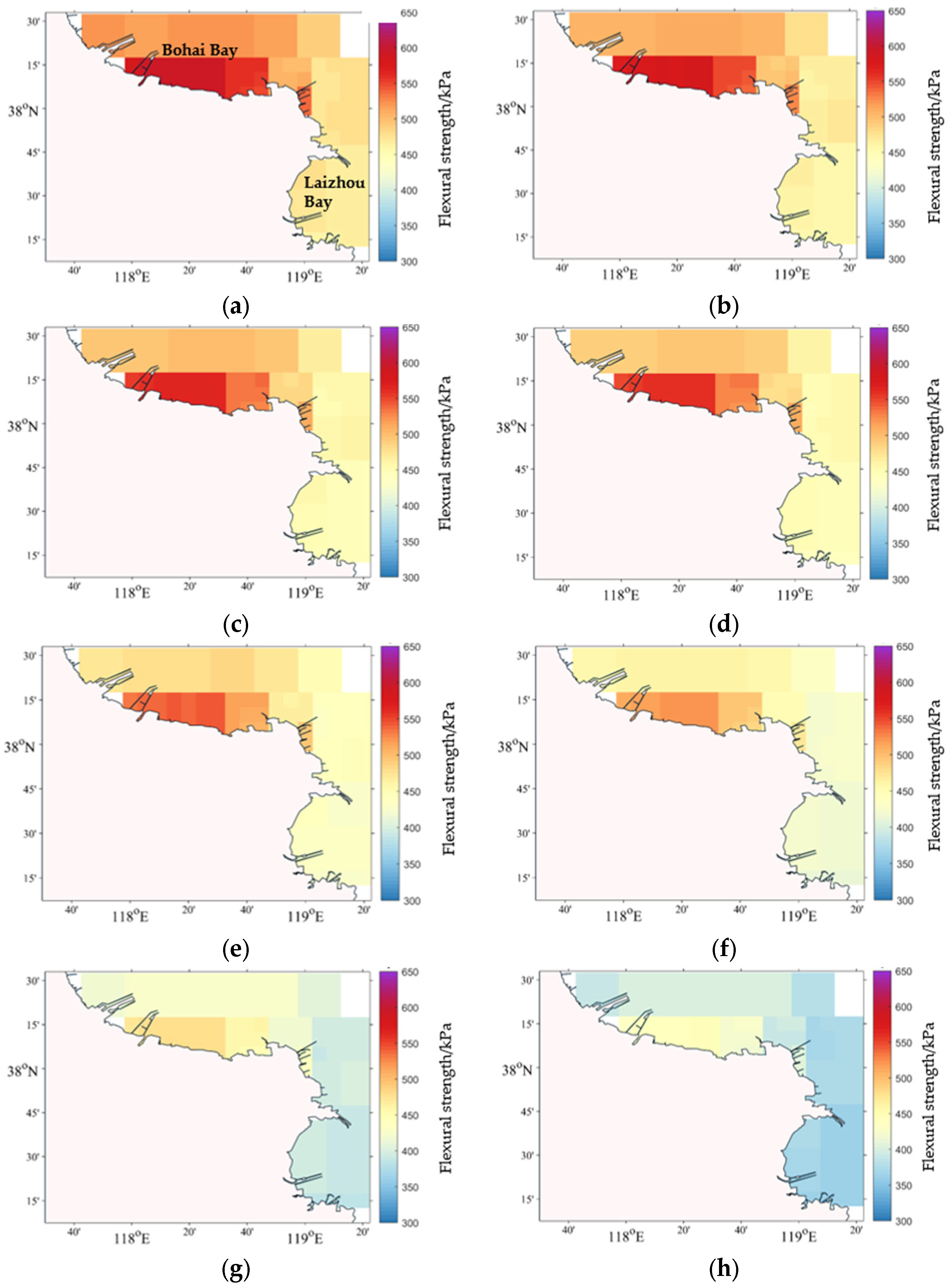

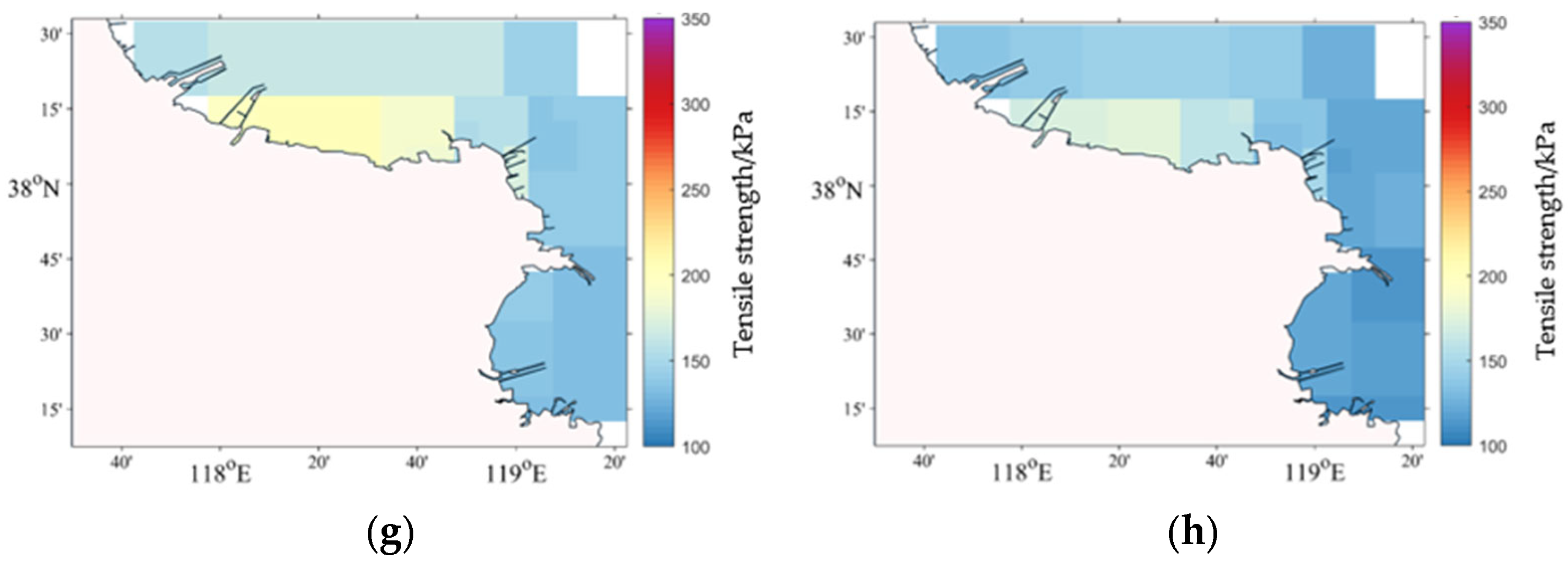
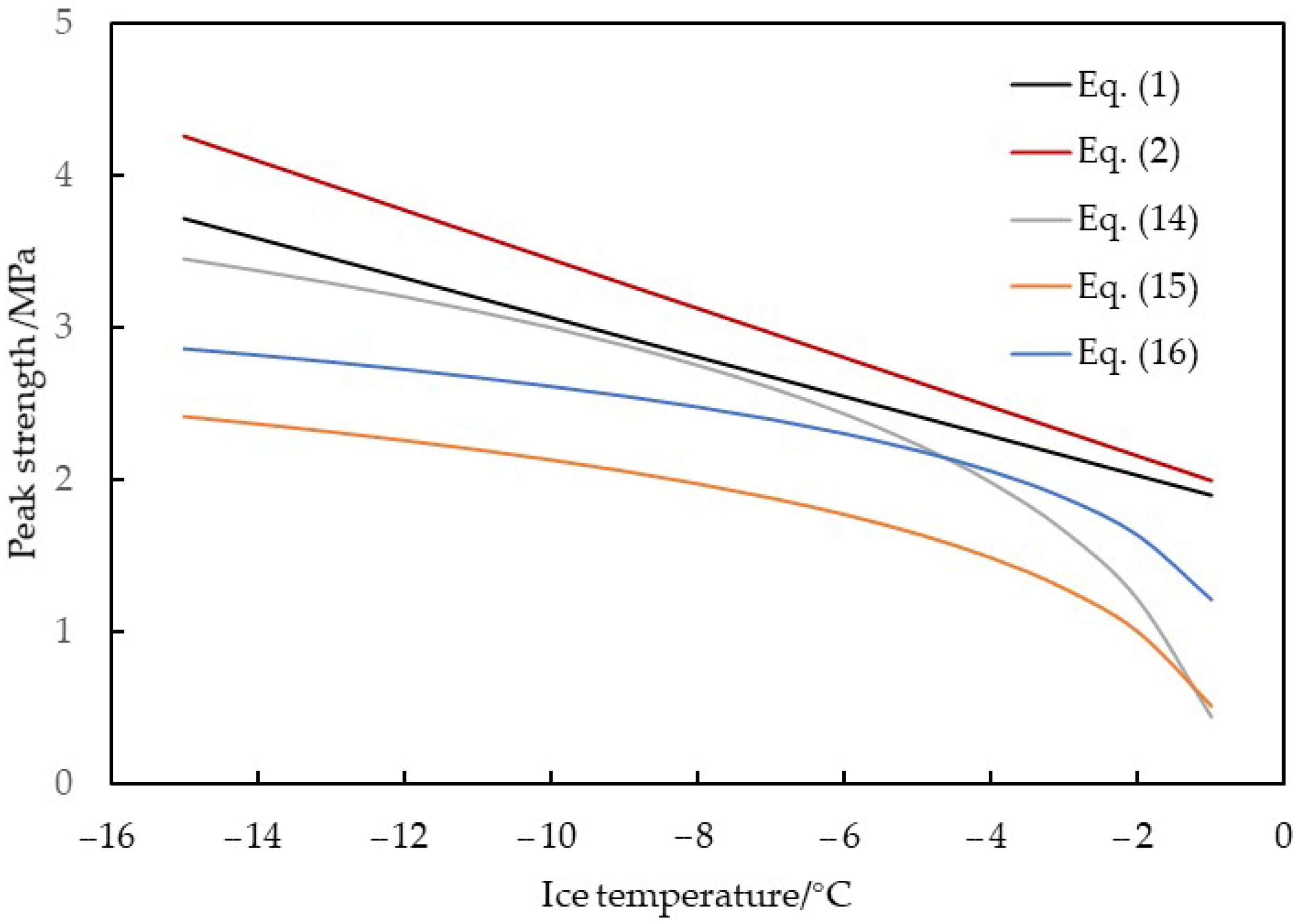
| Grid No. | Maximum/d | Minimum/d | Average/d | Grid No. | Maximum/d | Minimum/d | Average/d |
|---|---|---|---|---|---|---|---|
| 1 | 80 | 0 | 35 | 28 | 64 | 0 | 5 |
| 2 | 80 | 0 | 33 | 29 | 64 | 0 | 5 |
| 3 | 74 | 0 | 25 | 30 | 64 | 0 | 5 |
| 4 | 71 | 0 | 15 | 31 | 61 | 0 | 3 |
| 5 | 69 | 0 | 9 | 32 | 61 | 0 | 3 |
| 6 | 63 | 0 | 4 | 33 | 63 | 0 | 4 |
| 7 | 81 | 0 | 33 | 34 | 59 | 0 | 6 |
| 8 | 82 | 0 | 32 | 35 | 59 | 0 | 6 |
| 9 | 82 | 0 | 31 | 36 | 59 | 0 | 7 |
| 10 | 81 | 0 | 31 | 37 | 52 | 0 | 2 |
| 11 | 81 | 0 | 30 | 38 | 52 | 0 | 3 |
| 12 | 79 | 0 | 30 | 39 | 62 | 0 | 3 |
| 13 | 80 | 0 | 31 | 40 | 63 | 0 | 4 |
| 14 | 78 | 0 | 29 | 41 | 59 | 0 | 4 |
| 15 | 73 | 0 | 22 | 42 | 59 | 0 | 6 |
| 16 | 73 | 0 | 22 | 43 | 51 | 0 | 2 |
| 17 | 73 | 0 | 22 | 44 | 47 | 0 | 3 |
| 18 | 73 | 0 | 19 | 45 | 59 | 0 | 10 |
| 19 | 73 | 0 | 19 | 46 | 58 | 0 | 10 |
| 20 | 73 | 0 | 19 | 47 | 60 | 0 | 10 |
| 21 | 73 | 0 | 22 | 48 | 62 | 0 | 14 |
| 22 | 73 | 0 | 22 | 49 | 67 | 0 | 16 |
| 23 | 73 | 0 | 22 | 50 | 67 | 0 | 18 |
| 24 | 66 | 0 | 7 | 51 | 67 | 0 | 18 |
| 25 | 65 | 0 | 6 | 52 | 66 | 0 | 19 |
| 26 | 60 | 0 | 5 | 53 | 68 | 0 | 18 |
| 27 | 64 | 0 | 5 |
Disclaimer/Publisher’s Note: The statements, opinions and data contained in all publications are solely those of the individual author(s) and contributor(s) and not of MDPI and/or the editor(s). MDPI and/or the editor(s) disclaim responsibility for any injury to people or property resulting from any ideas, methods, instructions or products referred to in the content. |
© 2025 by the authors. Licensee MDPI, Basel, Switzerland. This article is an open access article distributed under the terms and conditions of the Creative Commons Attribution (CC BY) license (https://creativecommons.org/licenses/by/4.0/).
Share and Cite
Li, G.; Gao, S.; Chen, X.; Jiao, Y.; Wang, L.; Hou, Q.; Guo, D.; Zhao, Y.; Ruan, C.; Wang, Q. Designing the Engineering Parameters of the Sea Ice Based on a Refined Grid in the Southern Bohai Sea. Water 2025, 17, 2465. https://doi.org/10.3390/w17162465
Li G, Gao S, Chen X, Jiao Y, Wang L, Hou Q, Guo D, Zhao Y, Ruan C, Wang Q. Designing the Engineering Parameters of the Sea Ice Based on a Refined Grid in the Southern Bohai Sea. Water. 2025; 17(16):2465. https://doi.org/10.3390/w17162465
Chicago/Turabian StyleLi, Ge, Song Gao, Xue Chen, Yan Jiao, Linfeng Wang, Qiaokun Hou, Donglin Guo, Yiding Zhao, Chengqing Ruan, and Qingkai Wang. 2025. "Designing the Engineering Parameters of the Sea Ice Based on a Refined Grid in the Southern Bohai Sea" Water 17, no. 16: 2465. https://doi.org/10.3390/w17162465
APA StyleLi, G., Gao, S., Chen, X., Jiao, Y., Wang, L., Hou, Q., Guo, D., Zhao, Y., Ruan, C., & Wang, Q. (2025). Designing the Engineering Parameters of the Sea Ice Based on a Refined Grid in the Southern Bohai Sea. Water, 17(16), 2465. https://doi.org/10.3390/w17162465






